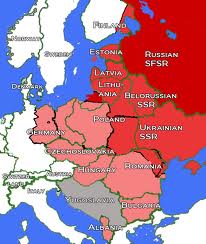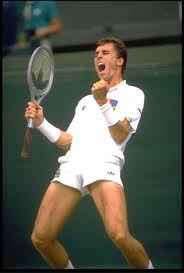The first tennis machine
I grew up, I was a child, in a non-TV tennis era. Any sort of machine in our house was simple, but a luxury. The TV was no exception. There was nothing on it, not compared to today anyway.
In the UK we had two weeks of Wimbledon, with one, sometimes two, matches available to watch in that period. That was it.
Not the machine's favourite - Wimbledon.
I then went to Germany.

München
Admittedly Germany had just discovered two tennis superstars, Becker and Graf, but as I had free moments I found tennis on the TV almost all the time - in halls in winter, on clay in summer. This was the first time when I saw anything other than grass court tennis, and the specific ways of playing on other surfaces. Now I discovered, in particular, two new surfaces, Indoor carpets, and, as the Germans call it, Sand.
There were some great Indoor carpet specialists, and, of course, as Agassi calls them in his autobiography, the “desert rats”, those Kings of sand. One pro crept up on the radar who had a great record indoors and on sand, and, high as he was on the world ranking list, played with an amazing lack of understanding on grass. This was my first role model - Lendl.

Desert Rats!
Lendl was not a popular player. He was a winner. He was a superb, clean technician, but his demeanour on the court didn’t appeal. He was grim, his face unflinching, and his shot-making was as robotic as you can imagine. There were no real variables in his game.
That is exactly why he became my first role model. He grew up in, as it was then, Czechoslovakia, where, typical of Eastern Bloc countries, strong emphasis was put on sporting development for youth. Not only was he immersed in sport as a child, with often brutal drilling on the programme every day, but he also learned the strategic mind-set that a professional sportsman must have. For me, he was the first “professional” top player.

Bloc
Maybe it’d help to define a professional. A professional in any field may display some of the following essentials : -
. Detailed preparation
. Technical Expertise
. Perfect Training facilities
. Tournament Programme Management
. A quest for efficiency
. Perfect manners vis à vis opponents, officials and partners. A machine can have manners This guy was right up my street. I had seen players like McEnroe, Nastase, Noah, Nastase and Connors, just to name a few. Lendl was on a completely different level if we are talking about professionalism. That much-misunderstood word, talent, was bandied around freely with a player like Nastase. Lendl was accused of having no talent. However, his great talent was his professionalism. I cannot exaggerate not only the image of “the perfect machine” that he projected, but also the way, eventually, all of our modern players have copied him. He was a trend-setter. I copied his mantra.
It’s difficult to pinpoint Lendl’s tennis talent, his exceptional ability. He was a slightly giraffe-like athlete, tall and rangy. Most tennis players are a bit on the compact side. That means even if they are tall they have strong, pumping, short-stepping, legs. Lendl didn’t fit this model. So he worked hard to make the best out of his legsy athletic-type. He was the first man to create a workout, advertise it, and be proud of it. His physical training regime was the first one, the original one. The fact that his was based around sprint–cycling is largely irrelevant. His workout regime was complete and fundamental.

The perfect tennis player
Everybody’s workout for tennis should be a little bit different. The differences are caused by body type, schedule and priorities. You cannot workout on everything all the time. You’d never hit a ball, or your body would get confused. A good workout regime is periodic and subject to modification. Great axes must be in place to correct, or maintain, the major concerns. With Lendl it was sprint power in his legs. He needed faster legs.
On his move to the USA he built a cycle track around his mansion. For the rest of his professional tennis life, he religiously raced on his bike, maintaining and improving performance, regulating it carefully with periods of tournament activity. The latter part of his career, when he started racking up Grand Slams, was, I would argue, only due to his extraordinary athletic preparation. Everything else was in place. The last, most difficult, piece of the jigsaw was relentlessly forced into the puzzle.
Trackcycling for tennis
I admire many things about Lendl. Technically he was very correct and simple. His execution was uncompromising, but logical and reasonable. He was a big hitter without racket violence or grunting or excessive spin. He hit a crisp ball. When he added technically to his game, for example he was a bit late developing his topspin backhand, he mastered the technique. His set-up was superb. He knew how he was going to win his points. He executed.
Groundstrokes from a tennis machine
I’m going to surprise you a little now. Lendl famously never won Wimbledon, and despite the attentions of that great volleyer Tony Roche, supposedly never learned how to volley. I think, if he had been around today, in our modern game, with our modern equipment, our modern schedules, he would have been a great volleyer. Technically he knew how to volley very very well, but with his set-up, on his favourite surfaces, with his opponents, he hardly used them. Wimbledon was a bit like an outing in the park for him. Important, yes, but not his bread and butter. Wimbledon had its specialists and he wasn’t one of them.
Just to finish, another surprise. Lendl gave great press conferences. He was funny, witty, not afraid to make fun of his player colleagues in the most waspish, tongue in cheek, way. He was never offensive or vulgar. His smile was most engaging. I thought this was beautiful.

Give great press conférences
Have A Great Story About This Topic?
Do you have a great story about this? Share it!
